Michael Houlihan
There is a facet of archaeology that is sometimes overlooked in Clare. It is stones related to funereal practices from the nineteenth century and possibility before.
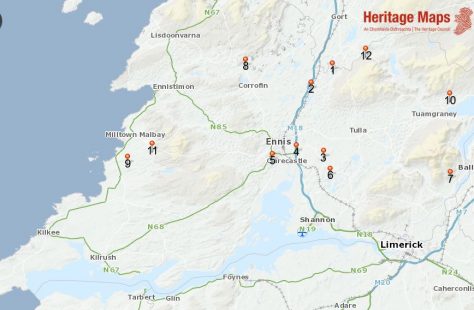
Location of Funeral Stones in County Clare.
1. Doon 2. Cloonmoney 3. Feaghquin 4. Killoo 5. Killone 6. Fenloe 7. Kilcredaun 8. Killinaboy 9. Kilbreedia 10. Clonrush 11. Kilernan 12. Fahy. Data from the basemap gallery accessed thorugh hertiagemaps.ie 5-7-2021
Without formal transport, pallbearers in funeral corteges rested coffins on their way to the church during long journeys on foot. In the graveyard, again the bearers would utilise ”coffin rests’ in the graveyard walls to assist with the movement of the coffin. These practices continued through the nineteenth century until finally replaced by hearses and formal undertakers.
As a final act of community, the coffin was shouldered by local men, sometimes travelling along narrow paths for some distance. Relays of men would take turns to get the corpse to its destination, with at least four shouldering the coffin at any one time and two more ready to step in as required.
When the cortège rested, it was not considered appropriate for the coffin to touch the ground. Consequently large stones were identified en route on which the coffin was placed. When ready to proceed, the stone made it easier to lift and carry on.
At the graveyard, there were again arrangements for handling the coffin. These came in the form of ‘coffin-rests.’ These rests are sections of the cemetery wall that are slightly lower than the parapet, with a reasonably wide and level section about a metre in length, fashioned to allow a coffin to rest without disturbance. These remaining rests usually have one or two stiles or stepping stones on either side to allow the bearers to enter with the coffin. Of 130 cemeteries in the county, at least 12 have coffin stones or coffin-rests in place. A mention of a commemorative stone in Quin is also included.
1. Doon Coffin Stone
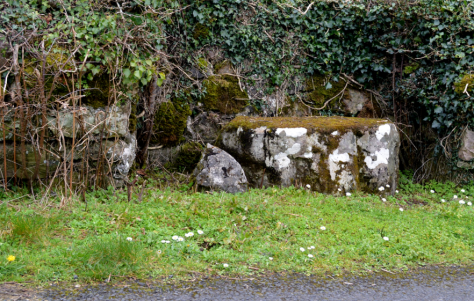
Coffin resting stone en route to Doon, Inchicronan.
Cloch na h-Onóra, Record of Monuments and Places (RMP) No. CL018-093
The stone lies on the grass verge of the road about half a kilometre from Doon cemetery. It is level at the top and was most likely fashioned that way. It is heavy, perhaps weighing 150-180 kilograms so that it would have taken a team of men to place it there in the first instance. It may have been moved closer to the wall to facilitate road works since last used. Its title, Cloch na h-Onóra, ‘the stone of honour’, suggests that its function went beyond offering a respite when carrying a heavy coffin.
The following description was collected by Máire Ní Lionnáin, Drumbonniv School, Co. Clare from William Linnane as part of the Schools Manuscripts Collection carried out by the National Folklore Commission in 1938.
‘Long ago when coffins were carried on men’s’ shoulders all the way to the cemetery it was customary to rest the coffin on certain large stones. This stone was called Cloch na h-Onóra’
It is also referred to by the same name in http://www.aughty.org/pdf/townlands_pres.pdf
‘A stone, called Cloch na h-Onóra may be seen on the road-side to Doon cemetery, which is three miles east of Crusheen.’
2. Cloonmoney, Inchicronan Coffin Stones
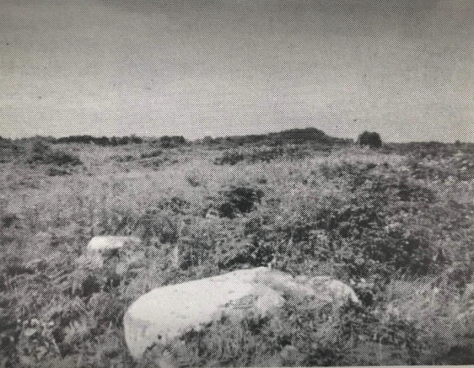
Coffin-resting stones, Inchicronan
RMP No. CL018-093.
This pair of coffin-resting stones (there are two, in spite of some descriptions) is proving difficult to locate. They may have been displaced in recent years during road improvements. Alternatively they may be absorbed into an new oak plantation.
The following information was collected by Máire Ní Lionnáin, a pupil at Drumbonniv School, from William Linnane as part of the School’s Manuscripts Collection, carried out in 1938.
‘Long ago when coffins were carried on men’s’ shoulders all the way to the cemetery it was customary to rest the coffin on certain large stones…One such flat stone may be seen on the old way to Inchicronan cemetery. The stone is in a field about a half mile south of Crusheen village (eight miles north of Ennis). A new road has been made to this. One such flat stone may be seen on the old way to Inchicronan cemetery. The stone is in a field about a half mile south of Crusheen village (eight miles north of Ennis). A new road has been made to this cemetery and the coffins are never left on this stone now.‘
The following description of the location and dimensions is from the National Monument Services recorded in 2016:
‘Situated in a rough overgrown area c. 10m E of a pathway to Inchicronan Abbey (CL026-014001-) indicated on the OS 25-inch map. Two undisturbed coffin-resting stones, 0.8m apart, one larger limestone one apparently used for adult coffins and a smaller one for children’s coffins. The larger stone (L 1.7m; Wth 0.93m, H 0.4m) is a natural limestone block aligned E-W. The surface slopes slightly to the W and is mostly flat with an uneven portion at E. The smaller stone (L 0.64m; Wth 0.54m; H 0.41m) is of sandstone and is aligned NE-SW with a flat and level surface and a straight edge at NW. There is no carving evident on either of the two stones.‘
3. Feaghquin, Quin – a possible Commemorative Stone
In the Schools Manuscripts Collection from the Clare area, Agnes Clune collected information from Martin Moylan of Feaghquin in1938, which detailed a leacht and a local custom in the village of Quin that pointed to something very close to the coffin stone tradition. The ‘leacht’ seems to have been a combination of coffin-rest and a commemorative cairn. Attempts to find the site have so far failed but I am certain that more will be learned.
‘There is a place in Feighquin called “leacht na marbh”. There is a round heap of stones raised to a point there. It is said that there is a chieftain buried there.
The reason it is called “leacht na marbh” is long ago the main road passed by the side of this leacht of stones. When a funeral was passing by, they used to rest the coffin on the top of the leacht, and everyone at the funeral would leave a stone on the “leacht.” (Schools Manuscripts Collection, 1938)
4. Killoo/Killow, Clarecastle Coffin Resting Stone
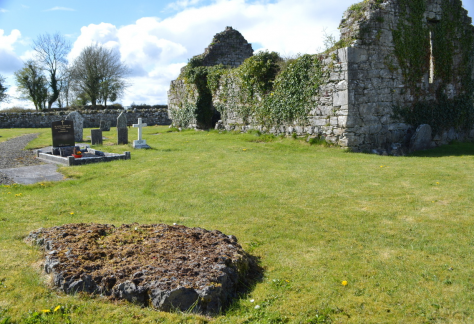
Coffin-Stone, Killoo, Clarecastle
The coffin-resting stone is in an open area, southeast of Killoo Church, close to the elaborate Lynch memorial. It is low to the ground but sufficiently large enough to accommodate a coffin.
The following description is provided in ‘Killow Graveyard, Clarecastle; a Short History’:
‘In the town land of Killow, Clarecastle, there is an ancient church and graveyard. There is no definite information available regarding the Church. It is probable that a Monastery was founded here about the middle of the 7th century AD by St Molua or Lugad of Killaloe. It seems to have survived the Viking wars and it became a Parish in its own right following the 12th century reorganisation of the Irish Church. The first record we have regarding this Church is the Papal taxation of 1302 where it is listed as a Parish with a valuation of 3 marks. It was united with Clareabbey later on.’
‘(Local man) Niall McCabe recalls his father Tom telling him of the tradition on a funeral day of the coffin pallbearers shouldering the coffin and resting it on a flat stone, possibly a Mass Rock in penal times which is situated in front of the Lynch vault. This stone was regarded as having healing powers and the belief was that the corpse left this world for a better life in heaven with all the pains and worries of this life removed.’ (Barry, F.)
5. Killone Nunnery, Newhall, Clarecastle
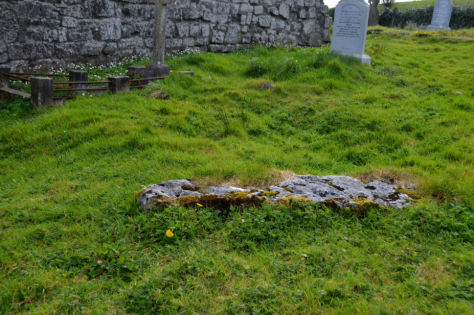
Coffin stone, Killone, Ballyea
Killone Nunnery was founded in 1190 by Donal Mór O’Brien, King of Thomond. It continued to function as a sister house of the Augustinian Abbey in nearby Clarecastle until the Reformation. Additional structures were added in the fifteenth century. The graveyard here was used into early modern times and may still receive a funeral to a family grave.
The coffin stone lies close to the west entrance of the added extension from the 1400’s. The stone is roughly rectangular in shape and about 10 cms high. It was intended as a platform to keep the coffin off the grass as this was considered both disrespectful to the dead and a possible source of ill luck.
6. Fenloe Coffin-Rest

Coffin-Rest, Fenloe graveyard, Newmarket on Fergus.
Fenloe in Newmarket on Fergus parish is beside Finn Lough lake, what lends it its name. It has a 14th century church, some sections of which may be earlier. It is probably best known for its founder, the sixth century Saint Luchtighern and his curative ‘plague stone.’
The coffin rest is on the west wall, necessitating entrance into the private field outside the graveyard. The tradition here is to take the coffin through the main gate and then exit through the gate on the west wall, into Costello’s field. A few metres to the north is a concrete platform, a stile and a coffin-resting stone in the wall. Here the pall-bearers place the coffin on the rest. There is also a stepped stile in the interior wall. Those inside the graveyard receive the coffin and carry it on to the grave. This is a practice of long duration.
‘When a corpse is to be buried in Fenloe Graveyard, they carry the coffin into the graveyard over the “steps” and not through the gate. They then carry it to a large flat stone where they lay it down for a while. They then kneel down around the coffin and say their prayers. They then carry it to the grave.’ (National Folklore Collection 1938).
7. Kilcredaun Coffin-Rest, O’Briensbridge
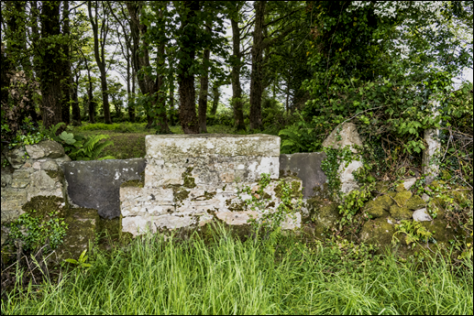
Kilcredaun coffin rest
Kilcredaun graveyard in the parish of O’Briensbridge is no longer in use. It lies surrounded by farmland some distance from the local R463 road. The coffin- rest contains a metre long horizontal stone with flagstones of slate on either side. There are steps inserted in the wall to facilitate entry to the cemetery while accompanying the coffin.
Inside, the cemetery has mature trees and widely spaced graves. At its centre is a Holy Well dedicated to Saint Credaun or perhaps Saint Senan, according to Westropp. The graveyard is included in the records as ‘Ross’ Holy Well, suggesting that adjoining Ross reaches into Kilcredaun town land here. The cemetery appears to have no gate, only a stile and stepping stones. Some of the graves here have a late 18th century dates.
8. Killinaboy (possible) Coffin-Rest
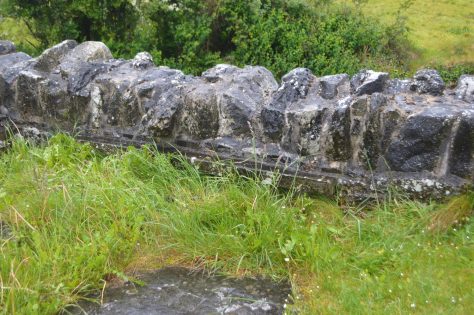
Killinaboy (possible) Coffin Rest
The old church at Killinaboy has the remains of what was likely a coffin-rest. The original church site may be as early as eleventh century, with the partial remains of a round tower to the south of the church. According to O’ Donovan and Curry (Ordnance Survey Letters 1839):
‘No part of this Church appears to be older than the 14th century except the west gable, which appears to be as old as the 11th century, and there is a tradition here that the whole of this Church except the west gable was battered down by Cromwell’s forces and subsequently rebuilt by the O’Briens of Inchiquin.’
The coffin-rest is now incorporated into the graveyard wall, facing the local R476 road. A flat section of wall of about 1.2 metres in length is covered by small top stones to match the ramparts on the rest of the wall, which may have been inserted at a later date.
The original coffin-rest feature has been lost to the public eye. Outside the wall, road works have pushed the grass margins in, placing the wall at the top of a slope here. The remaining feature is best detected from inside the graveyard.
9. Kilbreedia, Finnor More Coffin-Rest
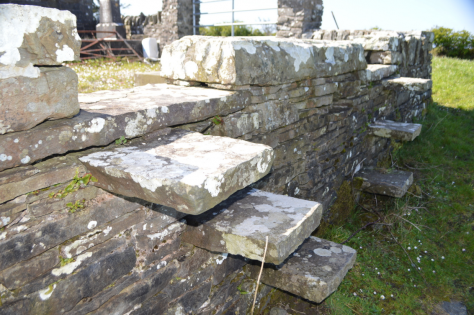
Coffin-Rest, Killbreedia, Finnor More, Mullagh
The coffin-rest is in the now disused Kilbreedia graveyard at Finnor More, beside Mullagh village. It is located at the west end of the graveyard, facing north towards the principal entrance to the site.
Kilbreedia in no longer the principal graveyard in the parish and is now rarely used. Essentially it became full and a new burial site was opened closer to the village church. The cemetery was extended at least once so that it incorporated an existing Holy Well at its east end.
The coffin rest consists of a heavy one-piece limestone slab about 1.4 metres in length, with cantilevered steps on either side to permit the pallbearers access after setting the coffin down. In recent years a large gate was added at the west end to permit easy access to the graveyard.
10. Clonrush Graveyard, Meelick Coffin-Rest
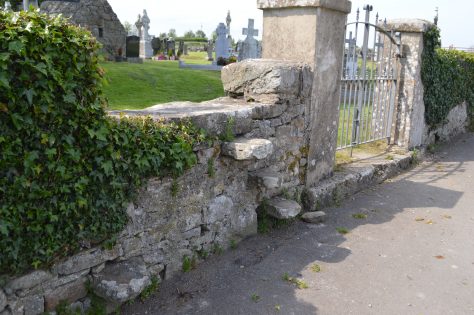
Coffin-Rest, Clonrush Graveyard, Lakyle (Whitegate)
Clonrush lies in a beautiful setting beside Lough Derg. Remains of a 12th century ecclesiastical settlement are found in the graveyard. The immediate area here is known as Church Bay. The graveyard contains a small vaulted house called St. Colman’s Oratory, with a Gothic doorway, also from the 12th century.
The coffin stone at Clonrush is to the left of the entrance gate, facing the car park. It consists of a lower section of wall, less than two metres in length and about 0.3 metres in width. There are two series of stones inserted in the outside wall, to the right and left of the resting stone, to provide steps when handling the coffin. The graves start immediately inside the wall.
Clearly as with all of the graveyards visited, the coffin stones here are part of the intrinsic infrastructure of the cemetery wall.
11. Killernan Graveyard, Kilmurry Ibrickane Coffin-Rest
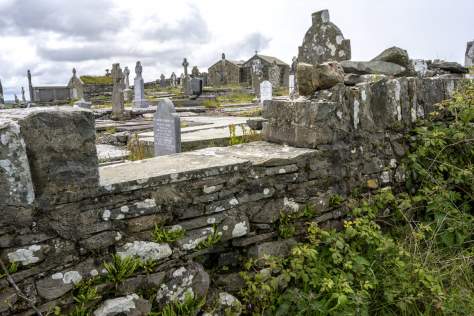
Killeranan coffin rest
Killernan graveyard lies at the summit of a small hill in rolling countryside close to Sliabh Callan in Kilmurry Ibrickane. It consists of one acre of graves and is clearly delineated by its enclosure walls. The cemetery has a significant number of early nineteenth crypts toward the front. It is flanked by two Holy Wells – a modern style ‘Tobermurry’ and a stone lined Tobermurrisk or possibly St. Erna, after the local saint. It contains the remains of a medieval church.
The coffin-rest is in the northwest wall of the graveyard. The accommodation for a coffin here is very deliberate, with about 1.3 metres of wall ~ 300 cms lower than the rest of the structure. An old grass path is discernible coming from the entrance gate to this spot, wide enough to cater for a modern hearse. Unlike the other coffin rests visited, this one has no steps or stile in place. However the wall here is of low enough height to allow for easy handling of a coffin.
12. Fahy, Lakyle Coffin Rest
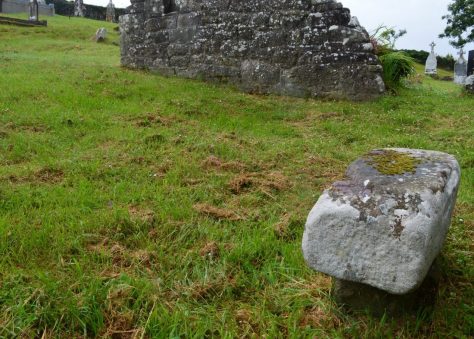
Coffin Stone in Fahy Graveyard, Lakyle
The coffin rest is immediately inside and to the right of the large double gate through which funerals would enter. It consists of a pair of stones – a small lower one on which sits a larger stone approx. 700cm X 300cm X 250cm. Both are fashioned of limestone that may once have been part of the ecclesiastical buildings, portions of which still remain in the graveyard. The local road is approx. 0.5 Kms. from the graveyard across fields, making it necessary to shoulder the coffin some distance.
Conclusions
What we have discussed here is one of several tangible remains of funeral practices found in Clare from the past. There are many others – cillíns/Kyleens, graves and tombs, gravestone iconography and inscriptions, and commemoration cairns. The customs, social and ritualistic interactions at wakes, funeral corteges, church and burial etiquette are even more numerous and enlightening. They all point to a communal response to ensure the dead person got ‘a good send-off ‘ from his neighbours.
What has been learned about coffin stones/coffin resting stones in this short survey is that they are far more numerous than originally supposed. All are found in cemeteries long in use. Only two stones have been assigned RMP numbers, while the others come under the general numbering for the graveyard or cemetery being surveyed. Perhaps in parishes which have ceased to maintain the tradition of shouldering or passing the coffin over the cemetery wall, these features are no longer noticed.
They point to a time when death and its rituals were local and communal. Back then, local community attended to all aspects of death, free of hospitals and undertakers and other external interventions. More coffin rests await identification in Clare.
Bibliography
Anne Ridge, Death Customs in Rural Ireland, Arlen House, Galway, 2012
Salvador Ryan, Death and the Irish: A Miscellany, Wordwell, Dublin, 2016
Clodagh Tait, Death, Burial and Commemoration in Ireland, 1550-1650, Palgrave Macmillan, New York, 2002,
John O’Donovan and Eugene Curry, Ordnance Survey Letters, 1839, Clasp Press, 1997.
Schools Manuscripts Collection https://www.duchas.ie/en/ppl/cbes/
National Monuments Service https://maps.archaeology.ie/HistoricEnvironment/
Frank Barry ‘Killow Graveyard, Clarecastle; a Short History’




No Comments
Add a comment about this page